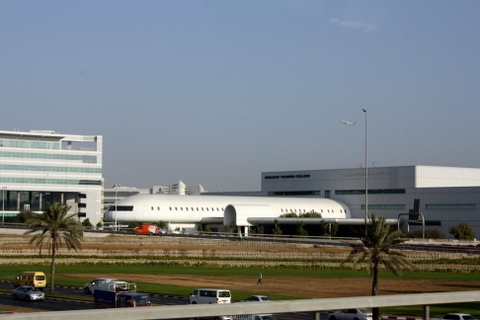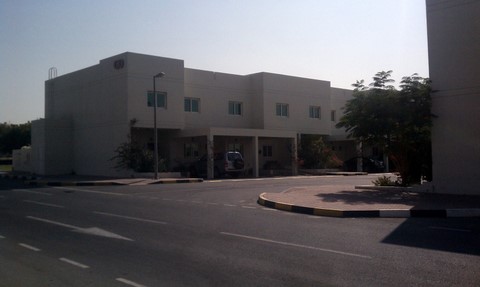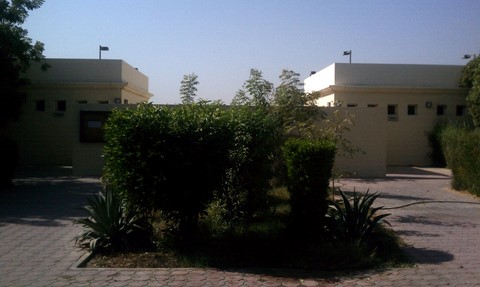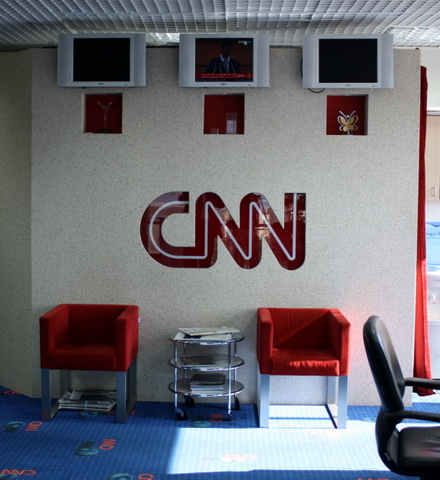This day started with another trip out to the American University of Sharjah. While I typically sat in the back of the van, I requested to sit in the front this day so I could get a clearer picture of the traffic (bad drivers, but not as bad as I thought) and so I could photograph buildings in Dubai. It’s amazing what people will build when they have more money than they really need. Dubai has its own pyramid-shaped building, like Vegas’s Luxor, because you’re not a real city unless you have a pyramid (I guess):

Oh, and how do you top the iconic nature of the Chrysler Building in New York City? Why, build two of them, of course:

And why shouldn’t the building where pilots train look like an airplaine? Emirates airlines thinks it should:

I haven’t mentioned labor camps until now, so I should describe them before I show pictures of them. Many of the lowest paid ex-patriot workers in the country are housed in what are called “labor camps.” They are basically shoddy dormitories or old homes that are literally filled with people, stuffing far more into a room than should be in a room. The older labor camps were out in the desert so no one could see them, but newer ones are a little nicer and are actually in Dubai. We asked our guide about visiting the labor camps and she said we couldn’t, which was disappointing (but some of us went anyway; more on this later). However, while driving around this day we saw some from the road and I shot a couple of okay pictures of them:


I also had to post this picture. It’s not very good, but it’s a gas station – just a random gas station in Dubai. Attached to it isn’t just one American fast food restaurant – Dunkin Donuts, but a second one, Pizza Hut. Most of the gas stations had attached fast food stations, like Burger King and Subway:

We had a little time before our first lecture/panel presentation this morning, so K. and I went for a walk around the campus. We found the faculty housing, which seemed nice enough:

We also saw the gym and other sports complexes. Unlike in the U.S., since men and women can’t exercise together, the gym is carefully scheduled, splitting the time pretty evenly between men and women. And this tennis complex had separate entrances for men and women and a wall between the men’s courts and the women’s courts:

After our little tour of campus, we returned to the lecture hall for our first presentation – a panel on media in the gulf. Panelists included Abeer Al-Najjar, an Assistant Professor of Communication at AUS (who also spoke the day before), Francis Matthew, the Editor at Large of Gulf News, which is one of the largest daily newspapers in the region, and Nabil Al Khatib, who is the Executive Editor of Al Arabiya news, one of the largest TV stations in the gulf and the Arab world. These were some pretty heavy hitters. This panel discussion was very interesting because they talked about the state of news in the Gulf region and how news works, generally, but it also focused on the Arab Spring and it’s implications, as well as the role of the media in it. Francis Matthew noted that 65% of the populations in the Gulf area are under 25, meaning young people really do matter and that governments had to pay attention to them, or else. Young people led the Arab Spring. Birth rates are declining, but the populations in the area remain quite young. He also said that demand for democracy is limited in the Middle East; the people in some countries don’t want it or, maybe better stated, aren’t ready for it yet. When I asked him about this, he suggested that it was an issue of education and modernization. As countries develop, they necessarily have to increase the education of the population. For instance, 250,000 young Saudis are going to school outside Saudi Arabia every year. But that is a double-edged sword. You need educated people to build the infrastructure of a country and to participate in the global market, but that also means exposure to political ideas that the leadership of the country may not like, including democracy. Mr. Matthews then suggested that the countries where the Arab Spring had or was taking place were countries that had developed earlier and/or countries where the regular citizens were not being sedated by cash transfers. However, he did think that increasing modernization would eventually lead to similar revolutions around the Middle East and that the days of autocratic rule were limited. Both panelists commented on the importance of new media (e.g., Facebook, blogs, Twitter, etc.), but said that traditional media in the Middle East had not been as damaged by new media as had traditional media in the West. Gulf News, for instance, still makes most of its money off its print edition. It is ready to try to transition to an online model, but it hasn’t seen a need for that yet.
I mentioned in my last post that the op-ed columnist, Mishaal Gergawi, had said that the media is not independent from the government in the Middle East. Both of this day’s panelists said they were largely independent. Gulf News seemed to have a more credible case in that it was owned by three businessmen, but they have ties to the royal family. Al Arabiya is owned by a Saudi who also has ties to the royal family. So, while they are technically independent, they aren’t practically independent. Additionally, just like media in the West, both of these media outlets are heavily dependent upon advertisers, and that is largely how their content is controlled. They both admitted that they were status quo media sources and that the new media is what pushed the envelope, because they are advertising dependent. If they start to do or say something as media outlets that the dictators in the various Gulf countries dislike, those dictators can pressure the owners of businesses to withdraw their advertising from the media outlet, which results in censorship indirectly by undercutting the funding for the media outlet.
As a numbers guy, I asked about statistics and viewership for the TV station. Mr. Khatib noted that they don’t have anything like Nielsen Media or any other particularly good measures of viewership for TV stations, but they do have three survey research firms that provide some statistics. They derive their statistics by calling viewers and asking them what stations they watched over the course of the day in 15 minute segments, which he admitted isn’t a great methodology for studying this. He said they are largely funded by the advertisers who want to know where to put their ads to maximize their impact. However, the TV stations get the data as well, so they know how they are doing compared to other stations. He also noted that the TV stations that are funded by groups outside the Middle East, like Alhurra, which is a US funded Arabic language satellite TV channel, have very low ratings – everyone knows they are propaganda. The UK and Russia have similar channels which are also seldom watched. Al Arabiya was the #2 network behind Al Jazeera. He also noted that many of the stations in the Middle East imported media from the West, but they tended to only allow shows that emphasized consumerism, which is how many of the dictatorial regimes distract their citizens – they have tried to get them to focus on materialism rather than freedom. He also noted that the average household watches 5 to 7 hours of TV a day in the region, but admitted that most of that is from people over 40; young people are increasingly turning to the internet for their media. This led me to ask about people aging into traditional media consumption; in other words, as people grow older are they likely to begin reading the paper and watching the news? They didn’t know.
We did eventually turn the discussion back to politics. Mr. Matthews argued that there were really only three socio-political views in the Gulf: conservatives, liberals (as in libertarians), and Islamists. There are no progressives in the Gulf. He argued that his paper was libertarian, not oppositional. It advocates for the free flow of information and reduced restrictions on people, but is not pushing for more progressive positions. Finally, Mr. Khatib made a very good point about the Arab Spring and the very problematic perspective on the revolutions both in the West but also in the countries where these revolutions took place. These countries have been governed by autocratic rulers for so long that the people in those countries don’t actually know how to live in countries that have greater freedoms. For instance, in Egypt, after Mubarak was overthrown, no one knew how to report the news. They had been censored by the Mubarak regime for so long that actually reporting the news without censors was novel to them. They didn’t know how to do it. He also emphasized that people have unrealistic expectations for how quickly the revolutions will result in positive outcomes for people in these countries. Democratizing a country years and maybe decades. It can’t be done overnight. Many aspects of the country have to change and people have to develop new ways of thinking. Thinking these revolutions will result in positive changes overnight is naive. I think this is a great point, especially in light of the recent Parliamentary elections in Egypt in which the Islamists won the greatest number of votes, despite young progressives being those who led the revolution. They have democracy, but the Islamists are taking advantage of it. In short, don’t expect flowering democracies to result from the Arab Spring in 2012; expect struggles, unemployment, frustration, and potentially even civil wars to result. If they can overcome these initial tensions, they may become stable democracies in 5 to 10 years.
We ate lunch on campus (as we did most days). AUS has a Starbucks, a Dunkin Donuts, and a Subway on campus.
After lunch we went to Media City in Dubai, which is basically just several buildings where international media companies have their headquarters. Lots of big media outlets are there – Forbes, CNN, Reuters, etc. We visited the headquarters of CNN Arabic. The Chief Operations Officer, Caroline Faraj, and a journalist, Samya Ayish, met with us. Ms. Faraj spoke at length about what CNN Arabic does and how it is run. Basically, it is an independent division of CNN that is self-funded. It only has a web presence, not a TV station or print media. Even so, it has over 6 million monthly views and over 1 million monthly unique visitors. I was expecting a massive media room with all sorts of telecommunications equipment, but it is actually run by just 7 full time employees in a mid-sized room in an office building. They do have cool carpet though – it has CNN on it!

They are financially independent from their parent company. Also, many of their news stories come from what they call “stringers” or independent journalists in the Arabic speaking world, since, with just 7 full-time staff, they don’t have time to do much reporting of their own, though they do some. I asked about competition and Ms. Faraj said they didn’t have any because they were the only media outlet in the Middle East that was completely independent from the government (mentioned that Al Arabiya was tied to the government, which somewhat contradicted what Mr. Khatib had said earlier in the day; this seems to be a big issue there). Many of their stories derive from what is trending on Facebook and Twitter in the Arabic world. They also noted that it is hard to get interviews with the leaders of the countries and that is why they often turn to social media for information and stories. Finally, they noted that they were in Dubai because of the favorable tax policies. Because they were located in Media City they didn’t have to pay taxes. Also, they didn’t have to be sponsored by an Emirati to be in the country but rather were sponsored by the government of Dubai as journalists and media experts. Oh, and they also gave us cool mugs that said CNN Arabic on them in Arabic.
From CNN Arabic we traveled back to Old Dubai and the textile souk. We did some shopping (I picked up some stuff for Debi and Toren). Here’s a photo of the textile souk:

We took a water taxi (abra) to the other side of Dubai Creek to the spice souk as well, but we were less interested in their wares over there. Even so, it smelled great. Here’s a photo of one of the spice vendors:

We had planned to go on a dinner cruise on the river, but they started at 8:30 and didn’t end until 11:00, which was just too late for us given the itinerary of the tour. So we opted for dinner along the waterfront. It was quite nice. Here was our view:

Oh, and we did find a rather interesting dish on the menu at that restaurant:

I was awfully tempted to try the “homos with fried meat” but decided I wasn’t in the mood for that kind of an adventure that night.
![]()
Leave a Reply